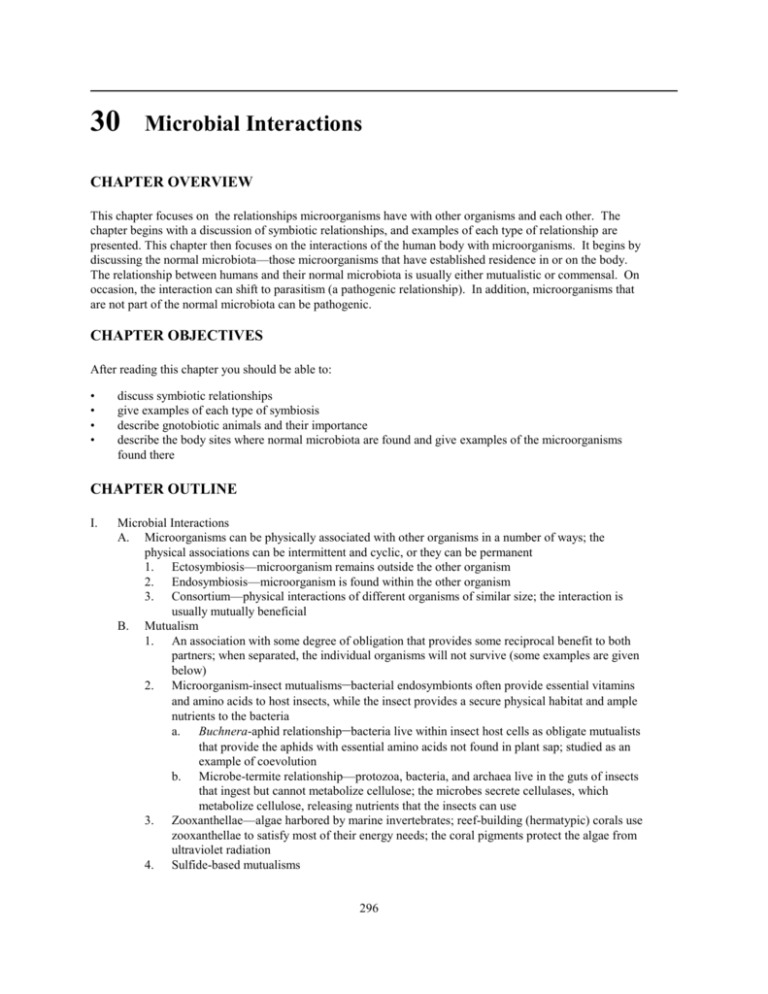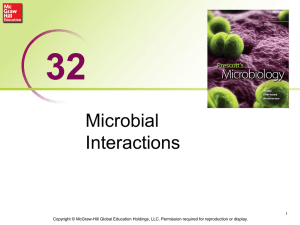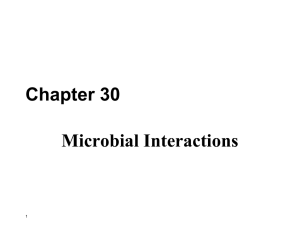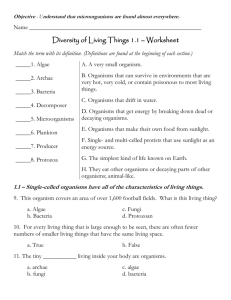Multiple Choice
advertisement

30 Microbial Interactions CHAPTER OVERVIEW This chapter focuses on the relationships microorganisms have with other organisms and each other. The chapter begins with a discussion of symbiotic relationships, and examples of each type of relationship are presented. This chapter then focuses on the interactions of the human body with microorganisms. It begins by discussing the normal microbiota—those microorganisms that have established residence in or on the body. The relationship between humans and their normal microbiota is usually either mutualistic or commensal. On occasion, the interaction can shift to parasitism (a pathogenic relationship). In addition, microorganisms that are not part of the normal microbiota can be pathogenic. CHAPTER OBJECTIVES After reading this chapter you should be able to: • • • • discuss symbiotic relationships give examples of each type of symbiosis describe gnotobiotic animals and their importance describe the body sites where normal microbiota are found and give examples of the microorganisms found there CHAPTER OUTLINE I. Microbial Interactions A. Microorganisms can be physically associated with other organisms in a number of ways; the physical associations can be intermittent and cyclic, or they can be permanent 1. Ectosymbiosis—microorganism remains outside the other organism 2. Endosymbiosis—microorganism is found within the other organism 3. Consortium—physical interactions of different organisms of similar size; the interaction is usually mutually beneficial B. Mutualism 1. An association with some degree of obligation that provides some reciprocal benefit to both partners; when separated, the individual organisms will not survive (some examples are given below) 2. Microorganism-insect mutualisms—bacterial endosymbionts often provide essential vitamins and amino acids to host insects, while the insect provides a secure physical habitat and ample nutrients to the bacteria a. Buchnera-aphid relationship—bacteria live within insect host cells as obligate mutualists that provide the aphids with essential amino acids not found in plant sap; studied as an example of coevolution b. Microbe-termite relationship—protozoa, bacteria, and archaea live in the guts of insects that ingest but cannot metabolize cellulose; the microbes secrete cellulases, which metabolize cellulose, releasing nutrients that the insects can use 3. Zooxanthellae—algae harbored by marine invertebrates; reef-building (hermatypic) corals use zooxanthellae to satisfy most of their energy needs; the coral pigments protect the algae from ultraviolet radiation 4. Sulfide-based mutualisms 296 a. C. D. E. F. Bacteria-tube worm (Riftia) systems use anoxic hydrothermal vent fluids rich in hydrogen sulfide; endosymbiotic chemolithotrophic bacteria in specialized cells (trophosomes) oxidize hydrogen sulfide for energy and to fix carbon supplied to the worm; hydrogen sulfide and oxygen are brought by worm hemoglobin to the bacteria b. Another gutless marine oligochaete (Olavius) harbors chemoautolithotrophic and sulfatereducing bacterial endosymbionts that digest waste products and provide fixed carbon 5. Methane-based mutualisms—methanotrophs are intracellular symbionts of methane-vent mussels and sponges that use the bacteria to support their nutritional needs; methanotrophs within sphagnum moss stems oxidize bog methane to carbon dioxide, that is then fixed by the plant, providing for efficient carbon cycling 6. The rumen ecosystem—bacteria in the rumen anaerobically metabolize cellulose to smaller molecules that can be digested by the ruminant; microorganisms produce the majority of vitamins that are needed by the ruminant; methane also is produced in the process and this contributes to global climate change Cooperation 1. A mutually beneficial relationship that is not obligatory, distinguishing it from mutualism 2. Linkage of the carbon cycle and the sulfur cycle by the relationship of sulfide-oxidizing autotrophic bacteria and heterotrophic organisms (e.g., other bacteria, crustaceans, nematodes, sponges, gastropods) 3. Linkage of the carbon cycle and the nitrogen cycle by the relationship of cellulolytic microbes and nitrogen-fixing bacteria 4. Syntrophism is an association in which the growth of one organism either depends on or is improved by growth factors, nutrients, or substrates provided by another organism growing nearby 5. In anaerobic environments, interspecies hydrogen transfer occurs; this involves the activities of fermentative bacteria, which produce low-molecular-weight fatty acids; the fatty acids are degraded by anaerobes (e.g., Syntrophobacter), producing hydrogen gas; methanogens consume the hydrogen gas during methanogenesis, and this promotes further production of fatty acids and hydrogen gas Commensalism 1. A syntrophic relationship in which the microorganism (commensal) benefits, while the host is neither harmed nor helped; in many cases, the microorganism shares the same food source with the host 2. Can occur in situations in which waste products of one microorganism serve as the substrate for another; nitrification requires the activity of two different species; one oxidizes ammonia to nitrite and the other oxidizes nitrite to nitrate 3. Can occur in situations where one microorganism modifies the environment, making it better suited for another microorganism a. Succession of microorganisms in an environment—during milk spoilage, synthesis of acidic fermentation products by one population stimulates proliferation of acid-tolerant microorganisms; during biofilm formation, the first colonizer makes it possible for others to colonize b. Colonization of surfaces of plants and animals by normal flora—plant or animal produces organic substances, which are used by the normal flora of the host organism Predation 1. Predator organism engulfs or attacks a prey organism; prey can be larger or smaller than predator; normally results in death of prey 2. Predatory microbes include the bacteria, Bdellovibrio, Vampirococcus, and Daptobacter 3. Positive outcomes of predation a. Microbial loop—microbial predators mineralize the organic matter produced by autotrophs (primary producers) before it reaches the higher consumers; this returns nutrients to the primary producers and promotes their activity b. Ingestion of prey provides protective environment for the prey Parasitism 297 1. G. H. II. A. B. C. D. III. A. B. One organism (parasite) benefits from another (host); there is a degree of coexistence between the host and parasite that can shift to a pathogenic relationship (a type of predation); once a parasite establishes the interaction with its host, over time it often loses unnecessary genetic information in a process called genomic reduction 2. Although once considered an example of a mutualistic interaction, lichens are now believed to be an example of a controlled parasitism between a fungus (ascomycete) and an alga (green alga) or cyanobacterium that only occurs when the two potential partners are nutritionally deprived a. Fungal partner (mycobiont) obtains nutrients from alga by hyphal projections (haustoria) that penetrate the algal cell wall, as well as oxygen for respiration b. Algal partner (phycobiont) is protected from excess light intensity and is provided with water, minerals, and a firm substratum in which it can grow protected from environmental stress Ammensalism—one organism releases a specific compound that harms another organism (e.g., antibiotics, bacteriocins, antibacterial peptides, and acidic fermentation products); attine ants are involved in a complex amensalistic process with bacteria and fungi Competition 1. Different organisms within a population or community try to acquire the same resources (e.g., nutrients, location) 2. If one of the two competing organisms can dominate, it will outgrow the other organism (competitive exclusion principle); in some cases the competing organisms share the limiting resource and co-exist at lower population levels Human-Microbe Interactions The normal microbial flora or microbiota are microorganisms normally associated with the human body; acquisition of normal flora is an adaptive process and the composition of the flora is dynamic The microbiome includes all of the genes of the host and its microbiota; these intimate relationships define the superorganism, a blend of microbial and human metabolisms Pathogenicity—the ability to produce pathological changes (disease) as the result of a parasitic symbiosis between a microorganism and a host; a pathogen is any disease-producing microorganism Gnotobiotic Animals 1. Gnotobiotic—an environment or animal in which all microbial species present are known or that is germ-free (e.g., mammalian fetuses in utero are free from microorganisms) 2. Gnotobiotic animals allow investigation of the interactions of animals with specific microorganisms that are deliberately introduced into the animal 3. Gnotobiotic animals are more susceptible to pathogens, but may be resistant to diseases caused by protozoa that use bacteria as a food source (e.g. Entamoeba histolytica) Normal Microbiota of the Human Body Internal tissues are normally free of microorganisms; however, many other sites are colonized; normal microbiota are the microorganisms regularly found at any anatomical site; while the fetus is free of microorganisms, newborns quickly acquire microbiota from the environment 1. Reasons to acquire knowledge of normal human microbiota a. It provides greater insight into possible infections resulting from injury to these sites b. It increases understanding of the causes and consequences of growth by microorganisms normally absent from a specific body site c. It aids awareness of the role these indigenous microorganisms play in stimulating the immune response Skin 1. Resident microbiota multiply on or in the skin; transients usually are unable to multiply on skin; most skin bacteria are found on superficial cells, colonizing dead cells, or closely associated with oil and sweat glands 2. Skin surface varies from one part of the body to another and generally is a hostile environment; skin surface undergoes periodic drying, is slightly acidic, is salty, and has antibacterial substances (e.g., lysozyme and cathelicidins) 3. Staphylococcus epidermidis and corynebacteria (dry areas and sweat glands); gram-negative 298 C. D. E. F. G. H. I. J. K. L. bacteria (moist areas), yeast (scalp); Propionibacterium acnes is associated with acne vulgaris and can change sweat gland secretions leading to body odor Nose and nasopharynx 1. Nose—just inside the nares; Staphylococcus epidermidis and S. aureus are predominant; they are also found on skin of face 2. Nasopharynx—above the level of the soft palate; contains nonencapsulated strains of some of the same species that may cause clinical infection (e.g., streptococci and Neisseria); other species also are found Oropharynx—between the soft palate and upper edge of the epiglottis; houses many different species, including staphylococci and streptococci Respiratory tract—no normal microbiota; microbes are removed by three mechanisms: continuous stream of mucous and the activity of ciliated epithelial cells that move the microbes out, phagocytosis of microbes by alveolar macrophages, and the bactericidal effect of lysozyme Eye and external ear 1. Eye—aerobic commensals are found on the conjunctiva 2. External ear—resembles microbiota of the skin; includes some fungi Mouth 1. Contains those organisms that survive mechanical removal by adhering to surfaces such as the gums and teeth 2. Normal microbiota include streptococci, lactobacilli, and actinomycetes 3. Some contribute to the formation of dental plaque, dental caries, gingivitis, and periodontal disease Stomach—microorganisms typically are killed by acidic conditions unless they pass through very quickly or are resistant to gastric pH; a few resistant genera are known Small intestine 1. Duodenum—few microorganisms present because of stomach acidity and inhibitory action of bile and pancreatic secretions; those that are found are gram-positive rods and cocci 2. Jejunum—Enterococcus faecalis, diphtheroids, lactobacilli, and Candida albicans are occasionally found 3. Ileum—microbiota resemble those of the colon (e.g., anaerobic gram-negative rods and Enterobacteriaceae) Large intestine (colon) 1. Largest microbial population of the body 2. Over 300 different species have been isolated from human feces; most are anaerobes or facultative organisms growing anaerobically 3. Normal microbiota are excreted by peristalsis, segmentation, desquamation, and movement of mucus, but are replaced rapidly because of high reproductive rate; the microbial community is self-regulating and can be disturbed by stress, altitude, starvation, diet, parasite infection, diarrhea, and use of antibiotics or probiotics Genitourinary tract 1. Kidneys, ureter, and bladder are normally free of microorganisms; though in both males and females a few microorganisms are found in distal portions of the urethra 2. Female genital tract hosts a complex microbiota in a state of flux due to menstrual cycle; Lactobacillus acidophilus predominates; it forms lactic acid and thereby maintains an acidic pH in the vagina The relationship between normal microbiota and the host 1. Relationship with normal microbiota is usually mutually beneficial 2. Normal microbiota help repel invading pathogens by a number of mechanisms (e.g., competition, production of inhibitory chemicals) 3. Establishment of a stable microflora has been linked to the induction of immune competency in gnotobiotic organisms 4. Under some conditions, normal microbiota can become pathogenic; such microorganisms are referred to as opportunistic 5. Compromised host—host that is seriously debilitated and has lowered resistance; is often 299 target of opportunistic microorganisms TERMS AND DEFINITIONS Place the letter of each term in the space next to the definition or description that best matches it. ____ 1. A relationship in which one organism benefits while the other is neither harmed nor helped ____ 2. An obligatory mutually beneficial association of two organisms ____ 3. A physical relationship in which two organisms remain outside of each other ____ 4. A physical relationship in which one organism lives inside another ____ 5. A relationship in which one organism releases a specific compound that has a negative effect on another organism ____ 6. A mutually beneficial relationship that is not obligatory ____ 7. A relationship in which one organism engulfs another ____ 8. An association in which the growth of an organism is dependent upon one or more growth factors, nutrients, or substrates provided by another organism in the same vicinity ____ 9. Animals that are germfree or that associate with one or more known species of microorganisms ____ 10. The microorganisms normally associated with a particular tissue or structure ____ 11. Germfree 300 ____ 12. Microbial systems involving interactions between a host and more than one symbiont ____ 13. Endosymbiotic dinoflagellates of invertebrates ____ 14. A relationship in which one organism is harmed while the other benefits ____ 15. The cyanobacterial partner in a lichen ____ 16. The ability of an organism to cause disease a. b. c. d. e. f. g. h. i. j. k. l. m. n. o. p. amensalism axenic commensalism consortium cooperation ectosymbiosis endosymbiosis gnotobiotic mutualism normal microbiota parasitism pathogenicity phycobiont predation syntrophism zooxanthellae FILL IN THE BLANK 1. A relationship between any two organisms that spend all or part of their lives in association with each other is called ____________. If the organisms remain outside of each other, it is called an ____________; and if one organism is found within the other, it is called an ____________. In many cases microorganisms live on both the inside and the outside of another organism; this is called an . 2. The discipline of is defined as the study of the interactions of microorganisms with their living and nonliving environment. The organism-organism interactions can take many forms. An example of a positive interaction is , an obligatory relationship that is mutually beneficial. An example of a negative interaction is , in which organisms compete for space or a limiting nutrient. 3. Herbivorous animals that have a stomach divided into four parts and chew a cud consisting of partially digested food are called . These animals have associations with the microorganisms that inhabit the upper portion of the stomach (the ). The microorganisms in this relationship are referred to as . 4. For many years, scientists thought were single organisms, and they were even given genus and species names. It was later determined that they are actually associations of an ascomycete fungus and an alga or a cyanobacterium. The fungal partner in the association is called the ____________, and the algal or cyanobacterial partner is called the ____________. Once considered to be an example of a relationship, they are now thought to be an example of a controlled . 5. Although is usually thought of as a negative interaction, it has many beneficial effects on both the predator and its prey. For instance, it can lead to increased rates of nutrient cycling, which is critical for the functioning of the . In this cyclic process, organic matter produced through photosynthetic and chemotrophic activity is mineralized before it reaches higher consumers, making inorganic nutrients available to the in the loop and promoting their activity. 6. If organisms compete for resources, two outcomes are often observed. In some cases one population dominates, excluding the other. This phenomenon is called the . However, in some cases the two populations may share the resource, each existing at a lower population level. 7. A is a physical association of different organisms that are often similar in size. In many cases the relationship is mutually beneficial. 8. One interesting outcome of parasitism is the loss over time of some of the parasite’s genes. This loss is referred to as . 9. Organisms whose microbial inhabitants are completely known are said to be ____________. 10. The mixture of microorganisms regularly found at any anatomical site is called the These microorganisms often offer some protection from transient microbes, but can become and cause disease under certain circumstances. When they do so, they are termed . Individuals with lowered resistance are called , and they are particularly vulnerable to such infections. 301 . MULTIPLE CHOICE For each of the questions below select the one best answer. 1. 2. 3. 4. 5. 6. 7. 8. 9. In lichens, the mycobiont sends projections of its hyphae across the algal cell wall in order to obtain nutrients from its photosynthetic partner. What are these projections called? a. mycelia b. hyphal extensions c. haustoria d. lichenthropes Which of the following is NOT true about the coral reef-zooxanthellae mutualism? a. The zooxanthellae provide most of the energy for the corals. b. The pigments produced by the corals protect the algae from harmful ultraviolet radiation. c. The rate of calcification (reef-building) is at least ten times higher in the light than in the dark. d. All of the above are true about the coral reef-zooxanthellae mutualism. In some symbiotic relationships, the microorganism benefits while the colonized plant or animal is neither helped nor harmed. What is the microorganism in such a relationship called? a. bacteriont b. commensal c. mutualist d. host How are the endosymbionts of ruminant animals useful to their hosts? a. They digest the cellulose of plant cell walls and provide organic molecules that the ruminant can metabolize. b. They produce most of the vitamins needed by the ruminant. c. They are digested as nutrients. d. All of the above are ways in which the endosymbionts of ruminant animals are useful to their hosts. Which of the following is a positive effect of predation? a. It contributes to the microbial loop. b. It may provide protection of prey from heat and damaging chemicals. c. It may aid pathogenicity. d. All of the above are positive effects of predation. What are the microorganisms normally associated with a particular tissue or structure called? a. indigenous microbial populations b. normal microbiota c. normal flora d. All of the above are correct. In the tube worm system, the bacterial partner obtains energy from what compound? a. hydrogen sulfide b. carbon dioxide c. carbohydrates d. methane Which of the following can use methane as a sole carbon source? a. methanogens b. methanotrophs c. methylotrophs d. None of these can. Which gram-positive anaerobe is the most abundant organism in oil glands? a. Frankia b. Raffia c. Pityrosporum d. Propionibacterium 302 10. Which of the following has the largest microbial community? a. stomach b. small intestine c. large intestine d. genitourinary tract 303 TRUE/FALSE ____ 1. ____ 2. Mutual advantage is central to many organism-organism interactions. The interactions of paired populations in ecosystems have no impact on the interactions of other pairs. ____ 3. Most disease-causing bacteria from the intestinal tract of humans and other higher organisms do not survive long outside of their hosts. ____ 4. The use of one organism to control the activity of another is called biocontrol. ____ 5. Skin microbes can be characterized as either transients or residents. ____ 6. Although gnotobiotic animals are generally more susceptible to infection by microbial and other parasitic organisms, they are almost completely resistant to dysentery caused by Entamoeba histolytica because they lack the bacteria that this protozoan normally uses as a food source. ____ 7. The male and female genitourinary tracts have nearly identical microbiota. ____ 8. Gnotobiotic animals are usually germ-free. ____ 9. Gnotobiotic animals are useful for studying the interactions of animals and specific species of microorganisms. ____ 10. The lower respiratory tract has an active microbiota that helps provide protection. ____ 11. Cathelicidins are antimicrobial peptides produced by sweat glands. ____ 12. Normal microbiota of the skin are protected by the enzyme lysozyme. CRITICAL THINKING 1. Explain the complex endosymbiont-tube worm relationship. Why has hydrogen sulfide been referred to as the “sunlight” of hydrothermal vent communities? 3. Compare and contrast mutualism, commensalism, and cooperation. Do the same for predation, competition, parasitism, and amensalism. 304 ANSWER KEY Terms and Definitions 1. c, 2. i, 3. f, 4. g, 5. a, 6. e, 7. n, 8. o, 9. h, 10. j, 11. b, 12. d, 13. p, 14. k, 15. m, 16. l Fill in the Blank 1. symbiosis; ectosymbiosis; endosymbiosis ecto/endosymbiosis 2. microbial ecology; mutualism; competition 3. ruminants; mutualistic; rumen; mutualists 4. lichens; mycobiont; phycobiont; mutualistic; parasitism 5. predation; microbial loop; primary producers 6. competitive exclusion principle 7. consortium 8. genomic reduction 9. gnotobiotic 10. normal microbiota; pathogens; opportunistic pathogens; compromised hosts Multiple Choice 1. c, 2. d, 3. b, 4. d, 5. d, 6. d, 7. a, 8. b, 9. d, 10. c True/False 1. T, 2. F, 3. T, 4. T, 5. T, 6. T, 7. F, 8. T, 9. T, 10. F, 11. T, 12. F 305








